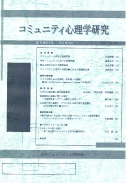Volume 10, Issue 2
Displaying 1-10 of 10 articles from this issue
- |<
- <
- 1
- >
- >|
Special Issues
-
2007Volume 10Issue 2 Pages 133-136
Published: March 30, 2007
Released on J-STAGE: October 17, 2020
Download PDF (361K) -
2007Volume 10Issue 2 Pages 137-144
Published: March 30, 2007
Released on J-STAGE: October 17, 2020
Download PDF (884K) -
2007Volume 10Issue 2 Pages 145-154
Published: March 30, 2007
Released on J-STAGE: October 17, 2020
Download PDF (891K) -
2007Volume 10Issue 2 Pages 155-161
Published: March 30, 2007
Released on J-STAGE: October 17, 2020
Download PDF (577K)
Special Article
-
2007Volume 10Issue 2 Pages 162-174
Published: March 30, 2007
Released on J-STAGE: January 07, 2022
Download PDF (814K)
Original Article
-
2007Volume 10Issue 2 Pages 175-185
Published: March 30, 2007
Released on J-STAGE: January 07, 2022
Download PDF (875K) -
2007Volume 10Issue 2 Pages 186-199
Published: March 30, 2007
Released on J-STAGE: October 17, 2020
Download PDF (1261K) -
2007Volume 10Issue 2 Pages 200-212
Published: March 30, 2007
Released on J-STAGE: October 17, 2020
Download PDF (1114K)
Case Reports
-
2007Volume 10Issue 2 Pages 213-224
Published: March 30, 2007
Released on J-STAGE: January 07, 2022
Download PDF (983K)
Academic Essay
-
2007Volume 10Issue 2 Pages 225-229
Published: March 30, 2007
Released on J-STAGE: January 07, 2022
Download PDF (529K)
- |<
- <
- 1
- >
- >|
